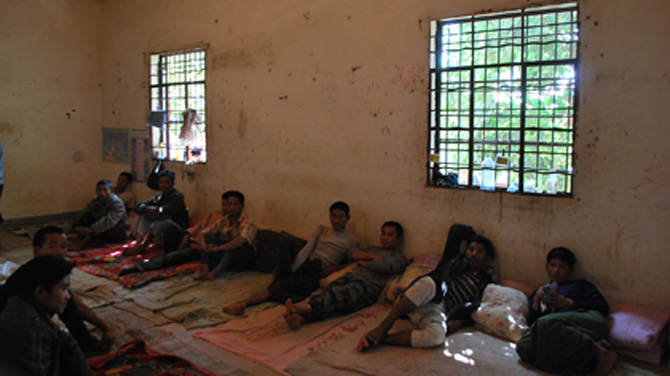No Saying No to Rehab in KIA Territory

LAIZA, Kachin State — After 10 minutes talking about her arrest and detention by the Kachin Independence Army (KIA), Ma Su Su wells up and a single tear dissolves a line through the cream-colored thanaka on her right cheek.
“I miss my children, yes, I do, a lot,” she says. For the past three months, she has been sharing a 10 x 10 foot cell with seven other women, since being caught carrying 40,000 yuan (US $6,350) worth of methamphetamines from China into Laiza, the capital of KIA-held territory in northern Burma.
A 15-meter wide river separates the two countries, making clandestine crossings relatively easy for those of a mind to do so. But Ma Su Su, an ethnic Burman from Bhamo in Kachin State, did not know that the KIA keeps a close eye out for drug smugglers at crossing points.
“I was promised 500,000 kyat [$625] to carry the pills to Laiza,” she says. “I usually only earn 2,000 kyat [$2.50] per day in Bhamo.”
Ma Su Su's cell is crowded and spartan: There are no beds, just floor mats, and two of the women there have babies staying with them in the grim-looking room. Three other women turn toward the two small windows at the back of the cell, refusing to pose for photographs or answer questions.
The cell is part of a KIA compound in which the armed group—which runs a de facto mini-state scattered across a patchwork of territory close to the China border—says it seeks to “reeducate and rehabilitate the drug carriers and drug users,” according to Capt. Hfaw Daw Gampa, who runs the facility.
“We have 112 people here at the moment,” he says. “Most of the people here are men and are drug users, rather than carriers, and 56 of the people here were referred to us by their families, while the others we arrested.” Most people stay three to six months at the center, he says, the duration of the stay depending on the extent of the addiction or the amount of narcotics found on the trafficker or mule.
One of the women in the cell was arrested by the KIO that same morning. Asa Bu, 30, says she is not a regular drug user. “I was just playing, I got it from my friends,” she claims. (Like Ma Su Su and the other detainees at the center, she asked that her name be changed to protect her identity.)
She is worried about how her family will react when they find out she has been caught with 3 grams of heroin and several dozen amphetamine pills. “They don't know yet. I just was brought here a couple of hours ago,” she says sheepishly. “I suppose the officers will call them soon.”
Standing next to Asa Bu is Seng Mi, age 34, cradling a 10-month-old baby. She acknowledges she was “more or less addicted” to heroin, but claims that she is “OK now,” five weeks into her detention at the drug center and after being given five days worth of methadone after she arrived. “I didn't take any drugs while I was pregnant,” she says.
Since the facility opened on Oct. 1, 2010, 843 people have passed through, only 92 of them female, according to Hfaw Daw Gampa. He and other KIA officials at the facility roll out some seized heroin and yabaa—slang for methamphetamines—that they say was seized from recent detainees. “The drugs come from Shan State, from militias linked to the army there,” they say. “It then is sent here through China.”
Opium cultivation in Burma—the world's second-biggest source country after Afghanistan—has doubled since 2006, with much of the increase coming from Shan State, south of Kachin, according to the UN Office on Drugs and Crime. Ethnic opposition activists blame militias linked to the Burmese army for the increase in production, pointing to the election to Burma's Parliament of known drug lords running under the army-backed Union Solidarity and Development Party (USDP), which has almost 80 percent of house seats in Burma's legislature.
But the KIA also has concerns about drugs produced on its own soil. “We have eradicated all opium growing here, around Laiza,” says the captain, before conceding that the KIA's opium eradication policy has not taken effect across all of its territory.
“Perhaps 6,000 acres of opium is still grown by farmers, but we are hoping to end this. We have paid out about 70,000 dollars in compensation, and want farmers to grow other cash crops,” he says, pointing to a noticeboard covered with photographs of KIA soldiers destroying opium plantations.
KIA officials murmur conspiratorial analyses of the extent of drug addiction elsewhere in Kachin State, in areas controlled by the government.
“Our intelligence estimates that 70 percent of the students at Myitkina University are addicted to drugs,” says one staff member at the facility, requesting anonymity.
1 | 2 next page »
|
||
|
||
|
||
|
||
|
||
|
||
|
||
|
||
- 'My Wife Died From Police Abuse,' Says Husband
- US Says Observer Conditions Don't Meet Int'l Standards
- 159 Observers to Monitor Burma Election
- Govt to Address Breaches of SSA-South Ceasefire: Aung Min
- Burma Investors Pin Hopes on Seminal Sunday
- Malaysia PM Leads 50-Strong Delegation to Burma
- US Congress to Assess Burma's Political Prisoner Issue
- Rangoon Woman in Police Station Death Plunge
- Burmese Legal System Remains Tool of Govt: AHRC
- Burmese Army Chief Defends Political Role
